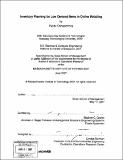| dc.contributor.advisor | Stephen C. Graves. | en_US |
| dc.contributor.author | Chhaochhria, Pallav | en_US |
| dc.contributor.other | Massachusetts Institute of Technology. Operations Research Center. | en_US |
| dc.date.accessioned | 2008-02-27T22:18:32Z | |
| dc.date.available | 2008-02-27T22:18:32Z | |
| dc.date.copyright | 2007 | en_US |
| dc.date.issued | 2007 | en_US |
| dc.identifier.uri | http://hdl.handle.net/1721.1/40386 | |
| dc.description | Thesis (S.M.)--Massachusetts Institute of Technology, Sloan School of Management, Operations Research Center, 2007. | en_US |
| dc.description | Includes bibliographical references (p. 81). | en_US |
| dc.description.abstract | A large online retailer strategically stocks inventory for SKUs with low demand. The motivations are to provide a wide range of selections and faster customer fulfillment service. We assume the online retailer has the technological capability to manage and control the inventory globally: all warehouses act as one to serve the global demand simultaneously. The online retailer will utilize its entire inventory, regardless of location, to serve demand. We study inventory allocation and order fulfillment policies among warehouses for low-demand SKUs at an online retailer. Thus, given the global demand and an order fulfillment policy, there are tradeoffs involving inventory holding costs, transportation costs, and backordering costs in determining the optimal system inventory level and allocation of inventory to warehouses. For the case of Poisson demand and constant replenishment lead time, we develop methods to approximate the key system performance metrics like transshipment, backorders and average system inventory for one-for-one replenishment policies when warehouses hold exactly one unit of inventory. We run computational experiments to test the accuracy of the approximation. We develop extensions for cases when more than one unit of inventory is held at a warehouse. | en_US |
| dc.description.abstract | (cont.) We then use these results to develop guidelines for inventory stocking and order fulfillment policies for online retailers. We also compare warehouse allocation policies for conditions when an order arrives but the preferred warehouse does not have stock although there is stock at more than one other location in the system. We develop intuition about the performance of these policies and run simulations to verify our hypotheses about these policies. | en_US |
| dc.description.statementofresponsibility | by Pallav Chhaochhria. | en_US |
| dc.format.extent | 81 p. | en_US |
| dc.language.iso | eng | en_US |
| dc.publisher | Massachusetts Institute of Technology | en_US |
| dc.rights | M.I.T. theses are protected by copyright. They may be viewed from this source for any purpose, but reproduction or distribution in any format is prohibited without written permission. See provided URL for inquiries about permission. | en_US |
| dc.rights.uri | http://dspace.mit.edu/handle/1721.1/7582 | |
| dc.subject | Operations Research Center. | en_US |
| dc.title | Inventory planning for low demand items in online retailing | en_US |
| dc.type | Thesis | en_US |
| dc.description.degree | S.M. | en_US |
| dc.contributor.department | Massachusetts Institute of Technology. Operations Research Center | |
| dc.contributor.department | Sloan School of Management | |
| dc.identifier.oclc | 191222012 | en_US |
